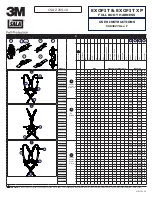
160
Chapter 13—Internal Effects
DM1000 Version 2—Owner’s Manual
When you turn on the SYNC parameter, the DM1000 recalculates the delay time or
modulation frequency based on the TEMPO parameter value (tempo) and the NOTE
parameter value (note). For example, if the TEMPO parameter is set to 120BPM and the
NOTE parameter is set to one eighth note, turning on the SYNC parameter sets the
delay time to 250 msec and the modulation frequency to 0.25 Hz.
•
TEMPO
......................... This parameter control sets the TEMPO parameter value in
BPM.
•
MIDI CLK
..................... Turning on the MIDI CLK by moving the cursor to this button
and pressing [ENTER] updates the TEMPO data based on the
MIDI Clock information received at the specified MIDI Rx
port. (The TEMPO data is not updated if the MIDI Clock
tempo is outside the range of 25 to 300 BPM.)
•
TAP TEMPO
................. You can also specify the tempo by moving the cursor to this
button and double-clicking the [ENTER] button. The DM1000
calculates the tempo based on the time interval between your
two taps (clicks) on the [ENTER] button. (The TEMPO data is
not updated if the tap tempo is outside the range of 25 to
300 BPM.)
G
Meters
These meters indicate the input or output levels of the currently-selected effects proces-
sor. Select the IN button or OUT button to display the input levels or output levels
respectively. There are eight meters when Effects processor 1 is selected; two when
Effects processors 2–4 are selected.
Move the cursor to a parameter you wish to change, and rotate the Parameter wheel or
press the [INC]/[DEC] buttons to adjust the setting. You can store the edited settings as
a new program in the Effects library (see page 177).
Tip:
• If you turn on the SYNC parameter and edit the TEMPO or NOTE parameter, the
DM1000 recalculates the delay time or modulation frequency.
• If you turn on the SYNC parameter and edit the delay time or modulation frequency,
the NOTE parameter value changes based on the TEMPO parameter setting.
Tip:
If the Freeze effect is selected, the TEMPO section displays the record and playback
buttons for using the effect, the recording data condition, and a progress bar that indicates
the current status.
Tip:
You can also view the input and output levels of the effects processors on the Meter |
Effect 1–4 pages (see page 39).
Note:
You cannot change the effects type on this page. To change the effects type, recall a
program that uses the desired effects type from the Effects library.
Summary of Contents for DM 1000
Page 42: ...42 Chapter 3 Operating Basics DM1000 Version 2 Owner s Manual ...
Page 52: ...52 Chapter 4 Connections and Setup DM1000 Version 2 Owner s Manual ...
Page 92: ...92 Chapter 7 Bus Outs DM1000 Version 2 Owner s Manual ...
Page 108: ...108 Chapter 8 Aux Sends DM1000 Version 2 Owner s Manual ...
Page 146: ...146 Chapter 11 Surround Functions DM1000 Version 2 Owner s Manual ...
Page 214: ...214 Chapter 16 Automix DM1000 Version 2 Owner s Manual ...
Page 385: ...DM1000 Block Diagram ...
















































